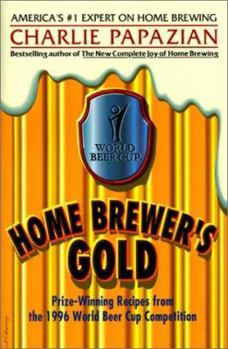Home Brewer's Gold: Priz
America's master home brewer shows you how to make the best beers on the world. In 1996, the brewers of the world met the ultimate challenge: the World Beer Cup International Competition. More than250 breweries entered their finest creations in sixty-one differentcategories before an international panel of beermaking experts.Only the most magnificent examples of the brewmaster's artqualified for the top award: the Gold Cup. And now, you can tasteall these prize-winning brews -- at home. Here's all you need to know to make five gallons of each Gold Cupchampion brew. Based on brewery data, lab analysis, tasting notes, and Charlie Papazian's quarter-century of home brewing experiencehere are recipes encompassing: British ales, bitters, porters, and stouts Ale in the American, German, and Belgian styles Pilseners Premium, dark, ice, and dry lagers Bocks Light beers Malt liquors Herb, spice, and fruit beers e Non-alcoholic malt beverages And much more. Chock-full of information about the winning breweries, brewing styles andinternational beermaking traditions, Home Brewer's Gold represents thestate of the art in home brewing. The world's best beers, served up by America's greatest home brewer -- This book's for you
Format:Paperback
Language:English
ISBN:0380791927
ISBN13:9780380791927
Release Date:December 1997
Publisher:William Morrow & Company
Length:448 Pages
Weight:0.75 lbs.
Dimensions:1.0" x 5.3" x 8.0"
Customer Reviews
1 rating
Recipes (and Stories) of Great Beers
Published by Thriftbooks.com User , 24 years ago
If this book were simply a collection of recipes for beers which won the 1996 World Beer Cup, it would be an interesting and valuable resource. But it's also an entertaining set of stories about these world-class beers, too. And everything is written in the inimitable Papazian style. From time to time, the author waxes poetic (as he has been known to do in his other writings). In his discussion of Founder's Stout, he writes how thankful the brewers did not adhere to the Bavarian Reinheitsgebot in producing this beer, so that roasted unmalted barley could be included. Both all-grain and extract/specialty grain recipes are offered for each beer, in a one-size-fits-all 5 US gallon length. Most homebrewers in the US will find this most useful. A couple of gripes which make this a four-star, rather than a five-star, review: First, the conversion between different units (e.g., SG to/from Plato, ASBC color to EBC color, and Fahrenheit to Celcius) is idoiosyncratic. The author does point out in his preface that EBC color values were derived, for the purpose of the book, by simply doubling the ASBC color. Secondly, the information on the cover gives the impression that the recipes are provided by the breweries, rather than being formulated by the author. In a sense, this is for the better, however, because the recips should be formulated by an experienced home brewer, rather than a professional. Still, I do not think it was entirely according to Hoyle to give such an impression. And the hokey "MBU," making its debut in this book, has to go. Homebrewers who work in metric usually use the number of grams of alpha acid in the hops. All in all, an entertaining and valuable reference.






